 You can get it at Amazon
You can get it at Amazon
 Bus
Bus
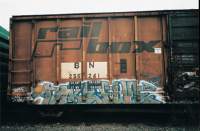 Take 5
Take 5
Books on graffiti and graffiti writers are no new thing. There is no mystery, especially to the graffiti writers, that mass culture is eating this stuff by the pound. While no politician in this country is looking to legalize graffiti, (that's a good thing) the use of graffiti style logos and imaging has become abundant in today's society.
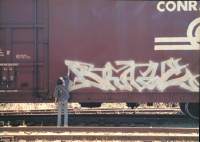 Braze
Braze
There is no arguing the impact that graffiti, both as an art form and a cultural movement, has had on the larger American popular culture. As graffiti continues to grow, specialization within the culture has inevitably started taking place. The wall writers, the bombers, the piecers, the throw-up kids, of course the train writers, and more specifically the freight writers.
 Look
Look
Graffiti on freight trains has been called the heir to subway graffiti. When the life of the subways ended and the regularly scheduled trains were pulled from service the estate was passed on to the fresher, larger railroad cousin, freights. "FREIGHT TRAIN GRAFFITI" is the only definitive history of this exciting and distinct branch of the larger graffiti culture. "FREIGHT TRAIN GRAFFITI," is jam-packed with hundreds of never seen before photographs and features in-depth interviews with more than 100 freight writers and train enthusiasts.
 Cavs
Cavs
From the beginning it was apparent to us that "FREIGHT TRAIN GRAFFITI" is really a story that had to be told by graffiti writers. In the past books focusing on graffiti have been written by onlookers. People who see a part of the culture and are so enthused with it that they see the need to preserve it. Otherwise they're written by one or two graffiti writers, which in many cases are only highlighting their respected perspective on the subject.
 Chip
Chip
For us, it was our goal to put something together that presented as non-biased of a perspective as possible. Truth be told, this is impossible. With any graffiti writer they are giving you their slant on the topic. It's in the nature of all graffiti writers to "rep" themselves and their crews. It's part of what makes graffiti so great, the loyalty and camaraderie. The challenge became to talk to as many freight writers as possible, from the first writers to hit freights to the most prominent and innovative pioneers of the art form. This was a nightmare. Hours and hours of tracking people down, phone call after phone call, email after email to find people that for all intents and purposes don't want to be found. Persistence pays off and eventually we had spoken with enough heavyweights that others really started to come around and were amazingly candid with their interviews and thoughts. It's really their lack of fear and willingness to share their stories that make "FREIGHT TRAIN GRAFFITI," the amazing project that it is.
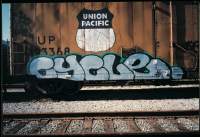 Cycle
Cycle
Freight trains have been getting hit for longer than your average graffiti writer may even expect. Growing out of a few chance meetings in the 70s and 80s, today the culture has exploded into a national art movement, but in its formative years, freight graffiti was made up of graffiti writers who looked at freights almost like a trash can or dumpster and saw little benefit from getting up on them.
 Denz
Denz
Soon their lackadaisical approach would inspire an army of Americas' youth who looked at freight trains as a chance for achieving national fame. It's this combination of opinions and views on the subject that was most difficult to present but which helps to show how dynamic and complex this group has become. From the original writers who could not have cared less about writing on freights to the current day freight train graffiti folk heroes, "FREIGHT TRAIN GRAFFITI," plots the development and provides an unprecedented perspective on the phenomenon.
 Free 5
Free 5
"I didn't write on a freight until the early 80s. I was in the Fresh Pine Yard [New York], and there is a freight system not too far from there. We had some paint on us so we would just tag a tanker car or something like that. To get to the last stop on the "M"s for the pull-in/pull-out, you'd hang out on the freight tracks down below and then you'd run up the hill when a train [subway] came in, to hit it. If a freight train happened to come by while you were waiting there, it was just like, 'Okay. It's metal: hit it'" -IZ THE WIZ
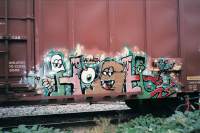 High
High
Some fifteen years later freights that were painted by people like IZ THE WIZ and ZEPHYR would become the graffiti that inspired kids across America to paint on freight trains. Individuals generally make decisions based on how they perceive their environment. The early New York writers perceived freights as a waste of time, something that could easily be replaced by a better use of spray paint like the hundreds of subway cars rolling around the city. The majority of the kids across America already interested in graffiti perceived freight trains as a connection to those New York subway idols and saw it as a sign that freights were worth painting on. This perception was truly validated when kids across the country simultaneously realized that freights do travel all over the country and that they were going to be the next big thing.
 Iz, Sach
Iz, Sach
"I'm proud to be a writer that knows about trains, that knows about freight-hopping, hobos and streaks, and different rail lines. I have a genuine interest in the railroad, the travel, and the circulation. It's like the beginning of Laverne and Shirley, when she puts the rubber glove on the beer bottle and it's gone. Where did that thing go?" - FAVES
 JE
JE
Quotes like these are helped along by more than 1000 images, 800 of which are color shots of the most influential freight train graffiti writers to date. "FREIGHT TRAIN GRAFFITI" chronicles how a fad in a few cities grew into a full-blown national phenomenon, from the first writers to ever paint freight through its spread in popularity leading up to the mass explosion of freight writers to surface in the mid 90s. This is not a book about what you will see on freights today -- this is a book on why you even see graffiti on freights at all.
 Jero
Jero
We must sincerely thank all of the writers who contributed their time, thoughts and photos, which people donated by the thousands. We'd also like to thank Michael Delahaut for his amazing design skills, as well as Caleb Neelon, Caroline Ryder, Simon Stienhardt, SMITH, ZEPHYR, KET, Bill Daniels, Ted Favin, Dave Schubert, and everyone who contributed along the way.
 Kaput
Kaput
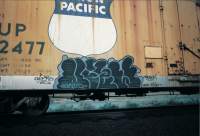 View
View